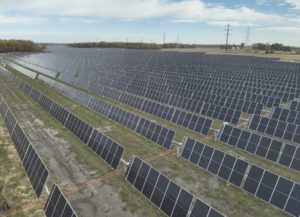Imagine a field of solar panels floating silently in the endless day of Earth’s orbit. Unlike their terrestrial cousins, this space-based solar array never faces nighttime, clouds, or atmospheric interference. Instead, they bathe in constant, intense sunlight, converting this endless stream of energy into electricity with remarkable efficiency.
But the true innovation lies in how this power is transmitted to power grids on Earth. The electricity generated in space is converted into invisible beams of microwaves or laser light that pierce through the atmosphere with minimal losses. These beams are precisely aimed at receiving stations on Earth—collections of antennas or receivers known as “rectennas” that capture and reconvert the energy back into electricity that can be supplied to the power grid.
This isn’t science fiction—it’s space-based solar power (SBSP), a technology that could revolutionize how clean energy is generated and distributed. While conventional solar panels on Earth can only produce power during daylight hours and are at the mercy of weather conditions, orbital solar arrays could beam massive amounts of clean energy to Earth 24 hours a day, 365 days a year, potentially transforming the global energy landscape.
“It’s not really that different from solar PV,” Dr. Leet Wood, chief energy advisor for the Space Frontier Foundation, explained as a guest on The POWER Podcast. “There are a number of different architectures that have been considered over the years, and I should point out that this concept has been around for a number of decades, but the one that we’re most focused on is a large-scale satellite with a large solar PV array in geosynchronous orbit.”
Because of the distance from the Earth and the inclination of the orbit, the panels would be in sunlight nearly all of the time, Wood explained, and it’s very easy to predict when they would be eclipsed. “That, right there, is one of the main differences,” Wood said. “You’re not having to deal with the day-night cycle. You’re not having to deal with weather. These solar panels are constantly irradiated.”
Wood explained that the direct-current (DC) power generated by the array is converted into a high-power microwave beam using technology very similar to already-existing military radar and beamed down to Earth where it’s received by a large rectenna, which is basically a large wire mesh. The incident microwave radiation is turned back into DC power and converted to alternating current (AC) power for use on the local grid. “There are different architectures that have been considered, but that’s sort of our baseline,” said Wood.
“The behavior of space-based solar power is unique as an energy resource,” Alex Gilbert, a fellow at the Payne Institute for Public Policy, said on the podcast. “It does resemble renewable energy in that it has relatively limited environmental impacts—you do have to consider the small emissions from rocket launches—but from a greenhouse gas perspective, it is likely to be a net carbon reducer.”
The technology also offers great flexibility in that the power can be beamed to anywhere within the line of sight of the satellite. “You have a lot more transmission opportunities in terms of siting,” Gilbert noted. “You can figure out where on the transmission grid that is the least constrained to put a rectenna station and have the power being joined in the grid. You can potentially split the beam. You can go to multiple different markets. And so, it kind of is unique in that it’s a baseload or dispatchable energy resource, but also has a lot more flexibility in terms of where you can site it.”
While the technology is well-understood and deployment has been contemplated for decades, launching the necessary equipment into space has been too expensive in the past to seriously consider. That is beginning to change, however, with advances being made by SpaceX and others. “That’s where we’ve seen a significant transformation in the space sector over the last 10 to 15 years,” said Gilbert. “Initially started and catalyzed most by SpaceX or more recently other types of launch vehicle providers like Blue Origin [Figure 1] and Rocket Lab, we’re seeing a transformation in how space is done. It’s no longer space for government applications with government oversight of traditional contractors; it is commercial space for government and commercial users, and the cost of launch is going down significantly.”

Gilbert noted that the U.S. is on the precipice of having two operational super-heavy launch vehicles that are the size of the Saturn V that sent astronauts to the moon. “That’s how you can reduce costs to a significant enough degree per kilogram that the economics of putting these power stations in space really start to look attractive and close, especially if you can start combining several launches together to create large stations in space,” he said.
“In addition to the economies of scale from having these enormous launch vehicles, the idea is that they would be reusable to some extent as well, which has an immense impact on the launch costs,” Wood added. “Because, right now, we throw away the entire rocket every time we put something into space, which is obviously an immense cost. If you could even reuse it once or twice, that fundamentally changes the economics of launch.”
A lot of learning around SBSP is taking place today. Many satellites are already in orbit that utilize solar power and the technology is proving to be robust and reliable in space. “To just get a sense of how quickly things are changing in space, six or seven years ago, there were zero Starlink satellites [Figure 2] in space. Now, there are about 7,000 or so. It’s growing rapidly, literally every single week,” Gilbert pointed out. “And if you actually look at the cumulative number of solar panels that they have and the total capacity, there’s now dozens of megawatts of solar power production on orbit with just that megaconstellation. So, Starlink is going to grow significantly. We also have Amazon Kuiper looking at doing another megaconstellation. China and Europe are looking at doing megaconstellations. We’re going to have hundreds of megawatts of solar power generation on orbit relatively soon.”

Yet, while the U.S. is the world leader in space technology, it’s SBSP program is lagging other countries. “We’ve seen major efforts in the European Union, in China, and in Japan, often led by governments,” said Gilbert. He noted that China, specifically, has a very explicit government policy to develop SBSP. “One of the programmatic problems here is that the U.S. government—the way that we do energy innovation—is not set up to support this resource. So, the Department of Energy does not really see this as a major area of innovation. It’s not something that they actually have—a space-based solar power program—at the Department of Energy. It would be just more generally treated as a generic energy technology,” Gilbert explained.
NASA, meanwhile, has repeatedly tried to raise SBSP technology in the past, and has been burned multiple times, according to Gilbert. Thus, it’s not something NASA has been inclined to actively pursue for Earth applications recently. “They have some early-stage research funding for things like lunar applications or satellite power beaming, and same with the DOD [U.S. Department of Defense] on that,” Gilbert said. “And so, as of right now, there’s not a lot of government dedicated support or research funding in the United States focused on this. But what we are seeing is that there have been a number of startups, really in the last 12 to 24 months, that are currently at the seed stage or trying to head towards their Series A—so venture capital-funded companies—to try and start developing this idea.”
Of course, funding the first SBSP plant is challenging. “The idea would be that for the first-of-a-kind plant, it would largely be government funding, and you would secure a governmental anchor tenant, whether that’s the DOD or any number of agencies that might benefit from having a secure islanded power source and be willing to pay a premium for it,” said Wood. “Then, stepwise, you would move through gradually socializing this amongst the private companies, traditional utilities, or new companies that would eventually take over a greater share of the development risk. But that initial risk and cost would be—for at least large-scale satellites—would almost have to be bought down by significant government buy-in.”
Like any technology still in the developmental stage, it’s hard to predict when a SBSP plant could realistically come online. “I think it depends largely on whether launch costs continue to come down at the rate that we’re seeing now or at the rates that we expect. It depends on the depth and vigorousness of government intervention, which again requires this unity of effort—this whole government effort—and to some extent, it also depends on how the energy markets evolve,” said Wood. “We’re going through an immense transition right now. For the most part, it looks like demand is increasing, but it is definitely a period of uncertainty. So, I think with sufficient government involvement, maybe working through public-private partnerships or international consortia, and if launch costs and market developments kind of go the way we think, you could possibly have something by mid-century. You could have a gigawatt-class plant—at least one gigawatt-class plant—up and running by mid-century. If you did more of a ‘Manhattan’ or ‘Apollo’ project—sort of full in effort—much, much sooner.”
Gilbert noted that a lot of research and demonstration work is actually in progress today, especially for laser-based technologies. “There’s a bunch of ground demonstrations happening where people are able to beam well over a kilometer, and that’s through atmosphere with dust and other things,” he reported. “Cal Tech has had a small endowment in this area and has been doing a lot of research. They did a very, very small-scale [demonstration] of actual power beaming from orbit down to the surface a couple years ago. And what we’re actually seeing right now is that in the next five years, we’re going to have the first on-orbit power-beaming demonstrations, again, focusing on lasers, because that’s where a lot of the DOD interest is right now, and that’s where the actual funding is. But we’re going to see that you’ll have those initial demonstrators, and if you start having a market, especially for space-to-space power beaming, that could happen a lot sooner than people think, because you don’t need to have very large systems for that. Just having several kilowatts would be really helpful for certain types of applications.”
To hear the full interview with Wood and Gilbert, which contains insight on research being done to advance SBSP technology, hurdles that must be overcome to achieve commercial success, the benefits SBSP could provide beyond 24/7 baseload power, how SBSP could flatten the “duck curve” in some regions struggling with steep net-demand peaks and valleys, and much more, listen to The POWER Podcast. Click on the SoundCloud player below to listen in your browser now or use the following links to reach the show page on your favorite podcast platform:
For more power podcasts, visit The POWER Podcast archives.
—Aaron Larson is POWER’s executive editor (@AaronL_Power, @POWERmagazine).










